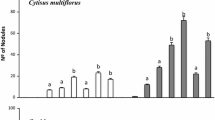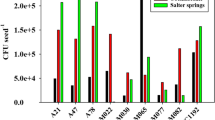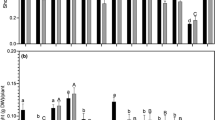Summary
Symbiotic effectiveness and competitive nodulation of the temperate forage legume sainfoin (Onobrychis viciifolia cv. Melrose) by two strains of arctic rhizobia (from Astragalus or Oxytropis sp.) and two strains of temperate rhizobia (from sainfoin) were evaluated at temperatures of 9, 12, or 15°C for roots and 20°C (day) and 15°C (night) for shoots. The inocula consisted of effective individual or paired arctic and temperate strains which were identified on the basis of differential growth. At 9°C, the arctic strains were generally more competitive than the temperate strains, whereas at the highest temperature tested, the converse was apparent. Symbiotic effectiveness (shoot dry weight, nitrogenase activity, and number of nodules) was similarly affected by root temperature, except that at 15°C the arctic strains were generally as effective as the temperate strains. The marked interaction between temperature and strain on competitiveness or on effectiveness indicates symbiotic adaptation of the arctic rhizobia to low temperatures. On the basis of these data we suggest that the use of selected, cold-adapted rhizobia in sainfoin inoculants may be beneficial in temperate regions where low soil temperatures occur early in the growing season.
Similar content being viewed by others
References
Bordeleau LM, Antoun H, Lachance RA (1977) Effets de souches de Rhizobium meliloti et des coupes successives de la luzerne (Medicago sativa) sur la fixation symbiotique d'azote. Can J Plant Sci 57:433–439
Caudry-Reznick S, Prévost D, Schulman HM (1986) Some characteristics of arctic rhizobia. Arch Microbiol 146:12–18
Gibson AH (1963) Physical environment and symbiotic nitrogen fixation: I. The effects of root temperature on recently nodulated Trifolium subterraneum L. plants. Aust J Biol Sci 16:28–42
Hardarson G, Jones DG (1979) Effect of temperature on competition amongst strains of Rhizobium trifolii for nodulation of two white clover varieties. Ann Appl Biol 92:229–236
Labandera CA, Vincent JM (1974) Competition between an introduced strain and native Uruguayan strains of R. trifolii. Plant and Soil 42:327–347
Layzell DB, Rochman P, Canvin DT (1983) Low root temperatures and nitrogenase activity in soybean. Can J Bot 62:905–971
Lipsanen P, Lindstrom K (1986) Adaptation of red clover rhizobia to low temperatures. Plant and Soil 92:55–62
Pankurst CE, Layzell DB (1984) The effect of bacterial strain and temperature changes on the nitrogenase activity of Lotus pedunculatus root nodules. Physiol Plant 62:404–409
Prévost D, Antoun H, Bordeleau LM (1987a) Symbiotic effectiveness of arctic rhizobia on a temperate forage legume sainfoin (Onobrychis viciifolia). Plant and Soil 104:63–69
Prévost D, Antoun H, Bordeleau LM (1987b) Effects of low temperatures on nitrogenase activity in sainfoin (Onobrychis viciifolia) nodulated by arctic rhizobia. FEMS Microbial Ecol 45:205–210
Prévost D, Bordeleau LM, Caudry-Reznick S, Schulman HM, Antoun H (1987c) Characteristics of rhizobia isolated from three legumes indigenous to the Canadian high arctic: Astragalus alpinus, Oxytropis maydelliana and Oxytropis arctobia. Plant and Soil 98:313–324
Rice WA, Olsen PE (1988) Root-temperature effects on competition for nodule occupancy between two Rhizobium meliloti strains. Biol Fertil Soils 6:137–140
Roughley RJ, Bromfield ESP, Pulver EL, Day JM (1980) Competition between species of Rhizobium for nodulation of Glycine max. Soil Biol Biochem 12:467–470
Russell PE, Jones DG (1975) Variation in the selection of R. trifolii by varieties of red and white clover. Soil Biol Biochem 7:15–18
Schulman HM, Lewis MC, Tipping EM, Bordeleau LM (1988) Nitrogen fixation by three species of leguminosae in the Canadian high arctic tundra. Plant Cell Environ 11:721–728
Sprent JI (1980) The biology of nitrogen-fixing organisms. McGraw-Hill, London
Thurman NP, Bromfield ESP (1988) Effect of variation within and between Medicago and Melilotus species on the composition and dynamics of indigenous populations of Rhizobium meliloti. Soil Biol Biochem 20:31–38
Trinick MJ (1982) Biology. In: Broughton WJ (ed) Nitrogen fixation: vol 2, Rhizobium. Clarendon Press, Oxford, pp 76–146
Vincent JM (1970) A manual for the practical study of root nodule bacteria. IBP Handbook 15, Blackwell, Oxford
Author information
Authors and Affiliations
Additional information
Contribution no. 413 and 1334 of the Agriculture Canada Sainte-Foy Research Station and Plant Research Centre, respectively
Rights and permissions
About this article
Cite this article
Prévost, D., Bromfield, E.S.P. Effect of low root temperature on symbiotic nitrogen fixation and competitive nodulation of Onobrychis viciifolia (sainfoin) by strains of arctic and temperate rhizobia. Biol Fertil Soils 12, 161–164 (1991). https://doi.org/10.1007/BF00337195
Received:
Issue Date:
DOI: https://doi.org/10.1007/BF00337195




